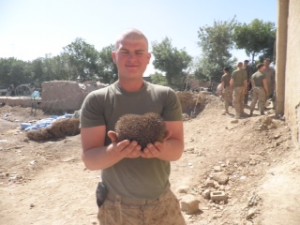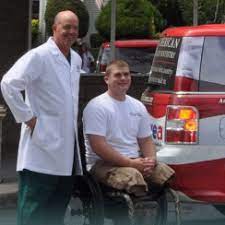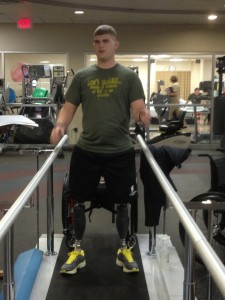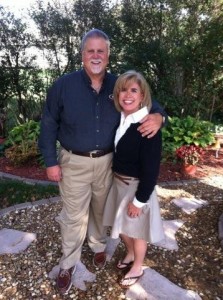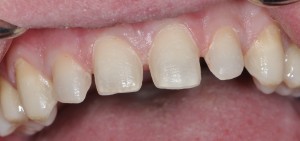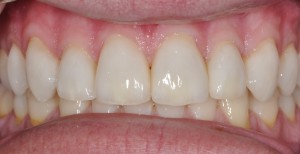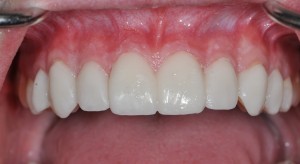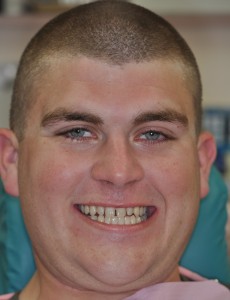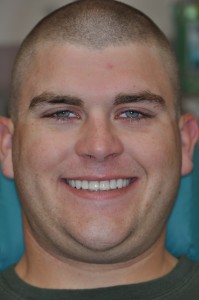RESTORING A HERO'S SMILE
It may surprise many of our patients that Dr. Rogers has a strong military connection. Following graduation from dental school, he served three years of active duty as a dentist for the U.S. Navy.
He shared this call to serve with his father, a veteran of WWII, and an older brother who flew combat aircraft in Vietnam. Although Dr. Rogers is no longer a member of the U.S. military, he continues to look for opportunities to support our troops.
Mike Boucher of Bogart, Georgia is a U. S. Marine and a Wounded Warrior. He also felt the call to serve his country. Without his parents’ knowledge, Mike enlisted into the U.S. Marines early in 2008. When he told his parents that he had signed up to become a Marine, they were not happy initially, but soon their support for their son’s choice grew.
Mike went to boot camp in December 2008. He deployed for the first time to Afghanistan only a year later. He remained there for eighteen months and returned to the United States in July 2010. After being home for less than a year, Mike deployed again to Afghanistan from Camp Lejeune, North Carolina, in direct support of the 1st Battalion, 5th Marines Bravo Company 1st platoon. He left in March 2011.
On June 12, 2011, three months into the second deployment, Mike was returning from night patrol when he and other members of his platoon heard an explosion. Even though they had just returned to their barracks, they quickly went back out to see what happened.
They were met with a horrifying reality of war: comrades had been hit by an Improvised Explosive Device (IED). Mike immediately went into “auto-pilot” and began helping the injured. While assisting his fellow soldiers, Mike was struck by an IED and lost both of his legs.
Upon injury, he was flown by helicopter to Bastion Hospital at Camp Leatherneck in Afghanistan and then to Bagram Air Force base in Afghanistan. After that, he was taken to Landstuhl Regional Medical Center and finally transported to Walter Reed National Naval Medical Center at Bethesda. He has been receiving physical therapy and rehab there since arriving on June 19, 2011.
In order to deliver the highest quality of dentistry available today, Dr. Rogers has developed a team of professionals. The dental laboratory is a key member of this team. They make all the dental restorations that Dr. Rogers bonds to the teeth.
It is a crucial element in the pledge to deliver the very best dentistry. NuCraft Dental Arts has been the one lab he has relied on to perform consistently for him and his patients over the last 20 years. The owner of NuCraft and master certified dental technician, Terry Fohey, is the man with the vision.
Terry first heard of Mike Boucher’s story from a friend at his church. Mike had plans to move back home, and the house needed modifications to make it accessible with his new injuries. Terry’s friend knew of a group of volunteers who needed help getting the house remodeled in time for Mike’s return. Terry has always been known as a “Get It Done” kind-of-guy so, when asked, he agreed to help without hesitation.
The first time Terry met Mike was at a homecoming ceremony held at Mike’s old high school in late fall of 2011. Terry had volunteered to cook for the large group that had come to support their local hero. Mike had made a promise to himself that he would not return home until he was able to stand and walk again with his new prosthetic legs.
What Terry remembers about that day is how Mike stood unwavering, sweat running down his forehead from the pain, yet meeting each person who wanted to greet him. Terry was so touched by the proud Marine’s story that he wanted to do more for him.
He visited Mike at Walter Reed National Naval Medical Center at Bethesda (WRNNMC) several months later, and the two began what might seem an unlikely friendship. As he got to know Mike better, Terry asked him why he never smiled. Mike’s reply was that he “hated his teeth.” Mike was not able to get braces or other dental work while he was a child.
Even as an adult, he was embarrassed by the gaps in his front teeth. It was an “aha” moment for Terry because he knew that he had the resources to help Mike smile again. And so, with the help of his old friend Dr. Rogers, the two came together in an effort to give Mike a new smile. Dr. Rogers would prepare Mike’s teeth for the veneers, Terry would fabricate them in his lab, and Dr. Rogers would bond them into place. Both Terry and Dr. Rogers felt a responsibility to give back to this young man who had sacrificed so much for his country.
Veneers are an aesthetic alternative for correcting a smile while preserving the natural tooth structure. This means that healthy teeth are not “cut down,” as is often necessary with decayed and broken teeth that require “caps” or crowns. When patients request the “Hollywood Smile,” dental veneers are often what they have seen that makes them want this highly aesthetic result.
In dentistry, a veneer is a thin layer of porcelain material placed over a tooth surface, either to improve the appearance of the tooth, or to protect a damaged tooth surface. Following minimal preparation of the teeth by a dentist trained in cosmetic dentistry, the porcelain veneer is designed from an impression of the newly shaped teeth.
This impression is delivered to the dental laboratory and the veneers are fabricated by a highly trained “Master Certified Dental Technician.” The training is necessary not only to prepare the teeth properly by the dentist, but also fabricated in the dental lab, and is seldom considered by the people who receive the care. Dental labs based in the U.S.A. will often have highly trained dental technicians, and Dr. Rogers strongly believes all patients should know where their dentistry is made.
Once a high-quality and aesthetic veneer is fabricated, it is “bonded” to the tooth by the dentist. Dr. Rogers has had advanced training in these procedures, which ensures not only the best cosmetic result, but also maximizes the “life span” of the veneers.
Mike Boucher was evaluated by both Dr. Rogers and Terry Fohey, and it was determined that dental veneers would give him the smile he always wanted.
This is Mike’s smile before we began his treatment. You can see the gaps in his front teeth that made him unwilling to smile in everyday life events. What you can’t see is Mike’s reluctance to smile for these photographs.
This is a picture of “minimal preparation” of the teeth to receive high-quality and aesthetic dental veneers. Minimal preparation means that only a surface amount of the overlying enamel is removed to accommodate the new surface of the teeth for placement of the veneers.
Many of our patients have referred to TV commercials that proclaim the new advances in “No Prep” Veneers … Lumineers ™. Though “No Prep” has its place in the optimal care of our patients, the use of this technique can often lead to “bulky” teeth, poor aesthetic color control, and below-average life expectancy of the restorations.
These are the pictures of Mike’s “temporary” veneers. These are placed at the initial appointment to serve as tooth replacement while the actual porcelain veneers are fabricated in the dental lab. The use of temporary veneers is one of the most important steps in this process.
Their purpose is more than to give the patient something to cover his or her teeth while the actual veneers are made. These temporary veneers also give the patient the ability to see and feel what the final restorations will be like once bonded to the teeth.
Equally important, they give a quality dental laboratory, like NuCraft Dental Arts, the ability to see and measure what the patient expects and also what is possible to deliver. This will enable the dentist and dental technician to meet aesthetic expectations while providing maximum longevity of the restorations.
These are the pictures of Mike’s teeth following the bonding of his “Permanent” Veneers. “Permanent” in dentistry does not mean “forever,” since all restorations have a maximum life expectancy. Depending on the age of the patient, some restorations will likely never need to be replaced. In Mike’s case, since he’s a young man, we can expect his veneers to last 10 to 30 years before they will require replacement.
Porcelain veneers, like all dental restorations, last longer based upon the commitment of the patient to proper hygiene at home, along with periodic (semi-annual) professional dental cleanings and examinations. The absence of harmful habits (grinding at day/night without proper protection), and the lack of trauma also play a big role in the longevity of dental restorations.
Mike is a happy man, given his past obstacles, and is eager to open the next chapter in his life. I hope we have given him, along with the excellent care of Walter Reed National Naval Medical Center (WRNNMC) at Bethesda, a future he can enter with all the energy and desire a young veteran can hope for.
Boucher is now married to Kaley and has a 4-year-old daughter and 1-year-old son. He recently had the implanted connection placed in each leg to replace the slip-on prosthetics. This has given him much greater mobility and comfort. He says his new nickname is “quick disconnect”. He can now drive with his legs, rather than hand controls. He is still living in the “homes for our troops” home next to fellow marine and double amputee Tony Mullis. He stays very busy with kids, hunting and fishing. He still has a beautiful smile that Dr. Mike Loden cares for. Dr. Loden reports the Dr. Rick Rogers did a terrific job.

